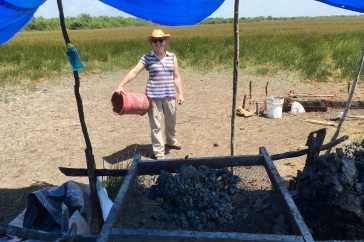
Blake Gumprecht, associate professor of geography and chair of the Geography Department
A Professor Uses Food to Teach Geography
Combine a cup and a half of late-season Quebec maple syrup and a cup of heavy cream. Thicken with cornstarch. Pour into blind-baked crust. Chill and serve.
It’s not the perfect recipe yet, says Blake Gumprecht, but it’s not bad. He’s one step closer to the ultimate French-Canadian maple syrup pie.
A geography professor, Gumprecht is also a lover of food. He has a passion for baking pies, sweet and savory, and makes his own bread. On any given day, he might whip up an Indian curry, Indonesian tempeh, or Spanish gazpacho. His love of ethnic food led him to create “Geography of Food,” a course that teaches students about regional geography through the study of foods around the world.
“Food is a perfect topic for introducing students to geography,” says Gumprecht, “because the food people eat in any particular place reflects so many different geographic elements — the environment, culture, economics, politics, history. It all comes together in what people eat. We don't tend to think of food in that way.”
The course is designed to be experiential. Though “just a gringo,” Gumprecht prepares sumptuous ethnic meals for his class. Students are encouraged to wander ethnic food stores and eat at ethnic restaurants. For one assignment, students must prepare their own regional cuisine.
“Eating ethnic foods is a way of traveling without having to get a passport or buy an airplane ticket,” notes Gumprecht. “If I’m eating at a little Turkish restaurant in Somerville, I'm transported in some small way to that place. Of course, I would rather go to Turkey than go to a Turkish restaurant, but I can’t do that every weekend and I can go to a Boston regularly. It's a way for me and for students to experience the world, close at hand.”
“Geography of Food” investigates American food, as well. A segment on North America teaches many students about the forces that shape their own food traditions.
Here in New England, much of what made food distinctive has faded, contends Gumprecht. Though clams, lobsters, and blueberries remain classic regionally-harvested foods, once distinctive dishes such as succotash and Boston brown bread are no longer staples. Baked beans, once a regional specialty, are now part of diets nation-wide.
“I don’t think that in 2012 New Englanders eat more baked beans than Texans,” says Gumprecht.
In the holiday season, traditional New England food — turkey, pumpkin, peas, carrots — will be prepared across the U.S. Thanksgiving is one New England food tradition the roots of which are remembered and celebrated. Witness the feast of the pilgrims and Native Americans of New England re-enacted in elementary schools across America.
For Gumprecht, a vegetarian who prefers ethnic foods much of the year, his Thanksgiving consisted of solidly North American cuisine: a vegetable pot pie, cranberry sauce, and pumpkin pie. Why? It seems spirited, he says. These are foods that embody “holiday” and “celebration” in this place and at this time.
What Gumprecht hopes for his students, though, is that “Geography of Food” will spark in them an unending curiosity about foods outside their own traditions—one that will lead them to eat the new and unusual food whenever possible—and not just because it is instructive to do so, but because it is fun.
It’s a pleasure he’s enjoyed for decades. “There’s nothing that I like more than to try a new ethnic restaurant or find a new ethnic grocery store and browse the aisles looking for something I’ve never seen before,” says Gumprecht. “The diversity of foods eaten around the world is wonderful.”
GEOG 588: Geography of Food will next be offered in spring 2013.
Originally published by:
The College Letter, Newsletter for the College of Liberal Arts
-
Written By:
Susan Dumais '88 '02G | College of Liberal Arts

















































